2025 Ultimate Guide to LPR Technology:
License Plate Recognition Transforms
Traffic Management and Security

In 2025, increasingly complex cities will encounter mounting traffic and security troubles, such as traffic congestion, strict speed enforcement, and the need to identify stolen vehicles. All of these demand efficient solutions. License plate recognition (LPR) technology emerges as a crucial element of modern infrastructure, powering diverse applications from smart traffic management to enhanced community security.
This guide explains how the license plate recognition system function, the specific challenges it addresses, and highlights how Milesight's AI-powered automatic number plate recognition (ANPR) cameras stand out with smarter (continuous deep learning AI model), faster (recognize within 0.1 seconds), broder (recognize plates of 50+ countries), and sharper (up to 98% accuracy) recognition capabilities.
What Does LPR Technology Mean?
LPR technology refers to license plate recognition technology that utilizes LPR cameras combined with sophisticated image processing algorithms to detect and read vehicle license plates. Due to the different regional naming conventions, LPR is often described as ALPR and ANPR interchangeably. Here's a breakdown of the terminology:
- LPR (License Plate Recognition): This term generally refers to the technology that reads license plates.
- ALPR (Automatic License Plate Recognition): Predominantly used in North America.
- ANPR (Automatic Number Plate Recognition): Commonly used in the UK and Europe.
LPR technology operates as part of a larger LPR system, which includes both the LPR camera and back-end software, typically hosted on an external server. The cameras automatically detect and capture license plates as vehicles pass through their field of view, also recording key metadata such as the date, time, and location. The system can also capture images of the vehicle and, in some cases, its occupants. All collected data is then transmitted to the back-end software, where it is stored for further analysis, reporting, or follow-up actions when needed.
How Does the LPR System Work: Full Chain Decryption
As surmised, the LPR system begins with the LPR camera capturing and reading license plates and ends with the final transmission to back-end software for analysis and insights. Here's a simplified breakdown of key parts: (or you can read the LPR technology white paper to learn more detailed information)
License plate detection
After capturing a license plate image, the system identifies and locates the license plate in the picture. It recognizes shapes and sizes that look like standard plates and ignores other irrelevant parts like bumpers or mirrors.
Character segmentation
After algorithms adjust the image for easier reading, the system splits it into individual character blocks. This step prepares the image for text recognition and handles things like:
- Different spacing between characters
- Special symbols
- Plates with two lines of text
Character recognition
Utilizing an AI model and OCR (Optical Character Recognition), the system reads the characters on the plate. It can recognize:
- Non-Latin alphabets (like Arabic or Cyrillic)
- Unique fonts or embossed text
- Country-specific formats and rules
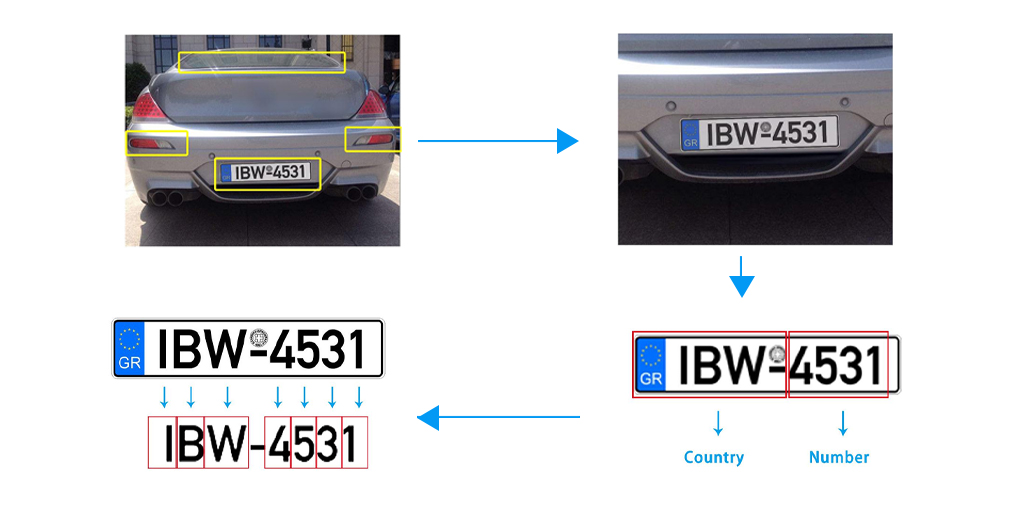
What are the Key Challenges in LPR Technology?
The effective implementation of the LPR technology in the real world often comes with distinct challenges. Overcoming these obstacles is essential for achieving accuracy and adapting to more widespread applications.
Achieving Consistent Accuracy
Accuracy is the cornerstone of any reliable LPR system—it directly impacts critical applications like traffic enforcement and security monitoring. Every step in the recognition pipeline, from image capture to license plate detection, must be finely tuned to maximize precision. Even minor errors in plate identification can lead to serious consequences, making algorithmic optimization essential for real-world deployment.
Performance in Challenging Conditions
High-quality image capture is half the battle won. However, real-world environments often present obstacles that test the limits of LPR systems:
- Low-light scenarios where plates become illegible
- Sudden lighting shifts (e.g., day/night transitions cause over/underexposure)
- Motion blur from high-speed vehicles on highways
- Glare and reflections off specialty plate materials
- Illegible vehicle image capture from a long distance
Without a high-resolution camera capable of adapting to these conditions, even the most advanced AI license plate recognition algorithms will struggle.
Handling Global License Plate Variations
License plate designs vary dramatically worldwide—not just in layout and typography, but also in:
- Shape and size (rectangular, square, or even non-standard contours)
- Character sets (special symbols, non-Latin scripts, or regional emblems)
- Formatting rules (single-line vs. multi-line arrangements)
Most LPR systems trained on a single country's plates suffer significant performance drops when faced with foreign designs. Truly robust solutions must account for this diversity to work reliably across borders.
What Features Do the Best LPR Cameras Have?
The best LPR cameras not only enhance accuracy but also integrate sophisticated capabilities that ensure reliable performance in various conditions. The following sections will explain how Milesight's innovative AI algorithms, high-quality image capture technologies, and the ability to read diverse plate formats collectively contribute to superior vehicle recognition. Learn more about Milesight PlateXpert here.
AI Algorithms Offer Accurate Recognition
Compared to conventional LPR that relies on basic OCR to read vehicle license plates as they appear, Milesight’s ALPR camera enables 100% in-house developed AI algorithms with continuous learning to deliver consistent and accurate recognition, intelligently delivering consistent 98% accuracy across diverse environments. Milesight AI LPR technology offers the following capabilities:
- Continuous Recognition & Optimal Result Selection: Starts continuous recognition once a vehicle enters the detection area and selects the optimal result.
- Small Plate Filtering: Filters out the small-sized license plate to prevent false readings.
- Confidence Level Metric: Provides a confidence level metric to further confirm the AI license plate recognition results.
- Trigger Line Recognition: Reduces wrong recognition by starting license plate recognition when a vehicle crosses a custom-defined trigger line.
High-Quality Captured Images for Car Plate Recognition
Accurate plate recognition depends on capturing high-quality images, even in real-world conditions. Milesight cameras include several technologies to ensure clarity:
- Frame parity flashing captures sequential images of moving vehicles and dynamically selects the clearest frames, avoiding the interference from complex lighting.
- A global shutter eliminates motion blur during high-speed scenarios.
- Dual-wavelength IR(740nm/850nm) maintains visibility in complete darkness or during rapid lighting transitions like dawn and dusk. It also optimizes recognition for diverse plates. The 740nm is ideal for low-contrast or reflective plates, while the 850 nm is ideal for high-contrast or non-reflective plates.
- Automatic parameter adjustment allows for dynamic adaptation to changing light conditions, ensuring optimal exposure during quick transitions from bright to dark environments.
- Smart IR control enables long-range license plate recognition - up to 630 feet.
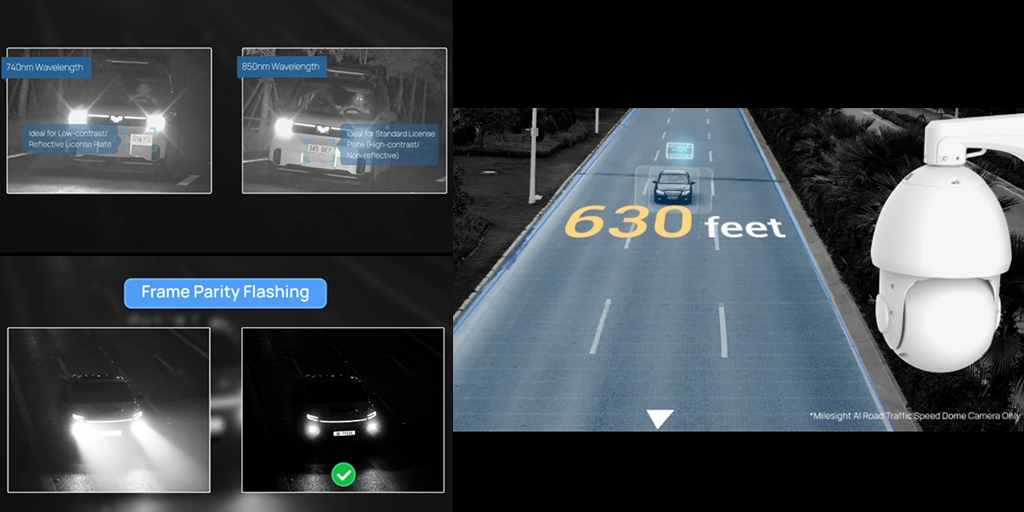
Capability to Read Specific Plate Rules
Milesight LPR system supports the recognition of various license plate formats and materials to ensure the highest accuracy in license plate recognition, including:
- Angled plates, multi-line plates, reflective materials, low-contrast characters, and ADR plates.
- Plates with special characters, spaces, and non-English scripts (e.g., Arabic, Japanese, German) — with unrecognized symbols shown as "-".
- Over 50 international formats are supported, including all EU countries, with ongoing AI training based on real-world data.
In addition to plates, the system identifies vehicle details like make, model, and color, offering valuable insights when plate data alone isn’t enough.
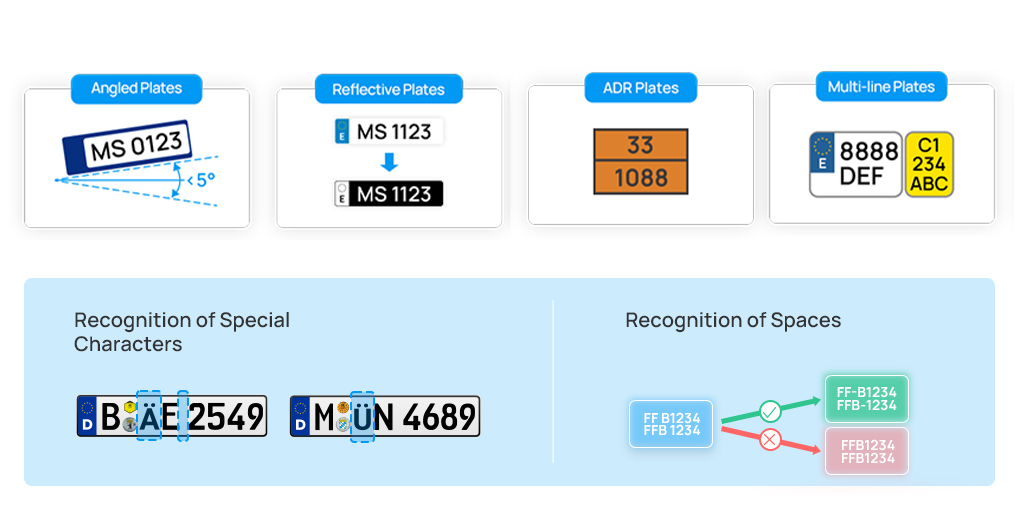
LPR Cameras: What are the Applications and Benefits?
License plate recognition technology plays an important role in organizations requiring efficient vehicle monitoring and traffic solutions. From public security to parking management, these systems are revolutionizing operations across multiple sectors.
Enhanced Security
LPR technology significantly bolsters security measures by providing automated vehicle identification for access control in gated communities, corporate campuses, and restricted areas. It enables real-time monitoring of vehicle movements, flagging unauthorized or suspicious vehicles, and triggering alerts for security personnel. Integration with black/white lists allows for immediate identification of vehicles of interest, aiding in crime prevention and investigation.
In conjunction with law enforcement, license plate reading cameras can help find stolen vehicles by identifying their information, triggering an alarm, and notifying nearby law enforcement to intercept them.
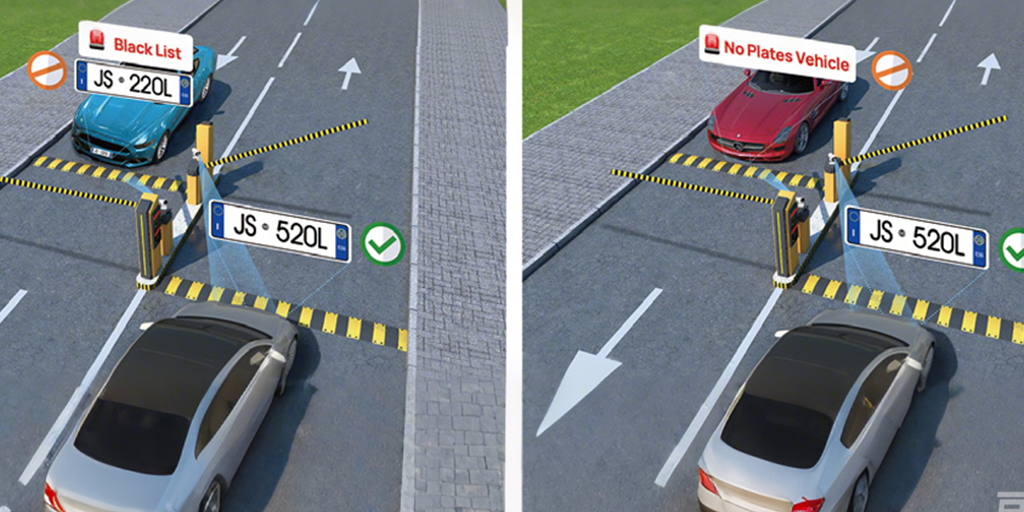
Smarter Traffic Management
ALPR technology is instrumental in creating more intelligent and efficient traffic management solutions across various applications.
- On urban roads, Milesight LPR enforcement cameras automatically catch traffic violations like speeding, running red lights, and wrong-way driving. With a dual-lens design, they simultaneously capture both an overview of the scene and a detailed license plate image, providing authorities with evidential data to enforce laws and improve road safety.
- In low-emission zones, ALPR cameras check vehicle compliance by reading license plates, allowing only approved vehicles to enter, reducing both congestion and pollution.
- On highways, ALPR technology enables efficient toll collection by allowing vehicles to be charged automatically without stopping, reducing congestion at toll collection. These systems also monitor vehicle flow and send real-time congestion alerts. For example, when congestions happen on the highway, Milesight's radar-integrated AI LPR cameras can detect drops in average speed and notify digital signage to alert drivers and traffic control centers of potential traffic buildup.
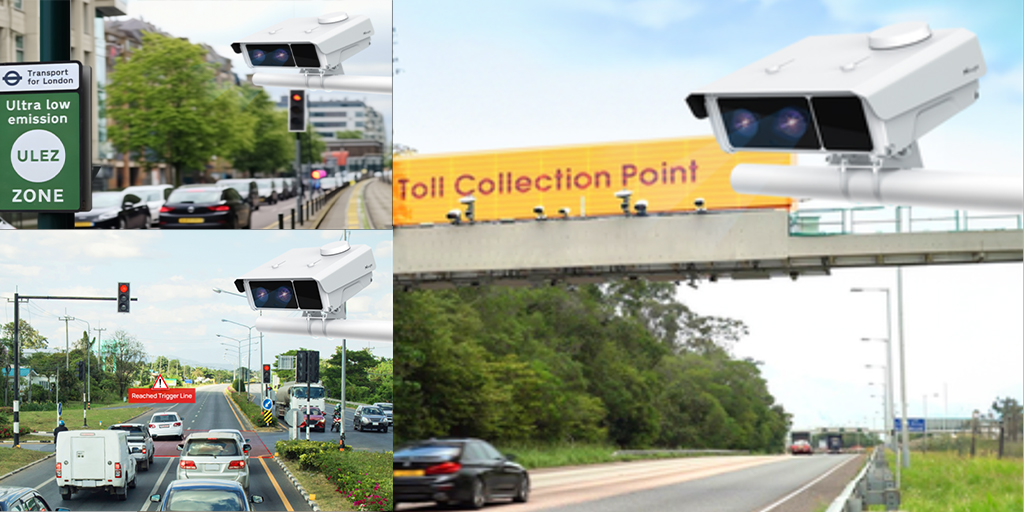
Next-Generation Parking Management
LPR technology is ushering in a new era of intelligent parking, transforming chaotic lots and busy streets into seamlessly managed spaces through automation and insightful data.
- For off-street parking, Milesight enhances the experience and profitability of both outdoor parking lots and indoor parking garages. It offers streamlined parking processes, real-time parking signage, and reduced waiting times to find available spaces. The detection analytics derived from license plate recognition enable smarter space utilization strategies for outdoor parking, capturing the occupancy status of 100 spaces and reading the license plates of 4 vehicles with different detection modes. For indoor parking, Milesight LPR cameras can detect the status of 6 spaces at once, indicating their availability to drivers using different colors.
- For on-street parking detection, license plate recognition technology is capable of detecting vehicles parked illegally, such as exceeding time limits or occupying restricted zones, and helps enforce rules fairly and consistently.
- Milesight license plate readers support the seamless evidence linkage with the traditional security cameras, and integrate their data with Zatpark, which is an innovative parking management and enforcement online platform, delivering comprehensive insights for city planners and parking operators.
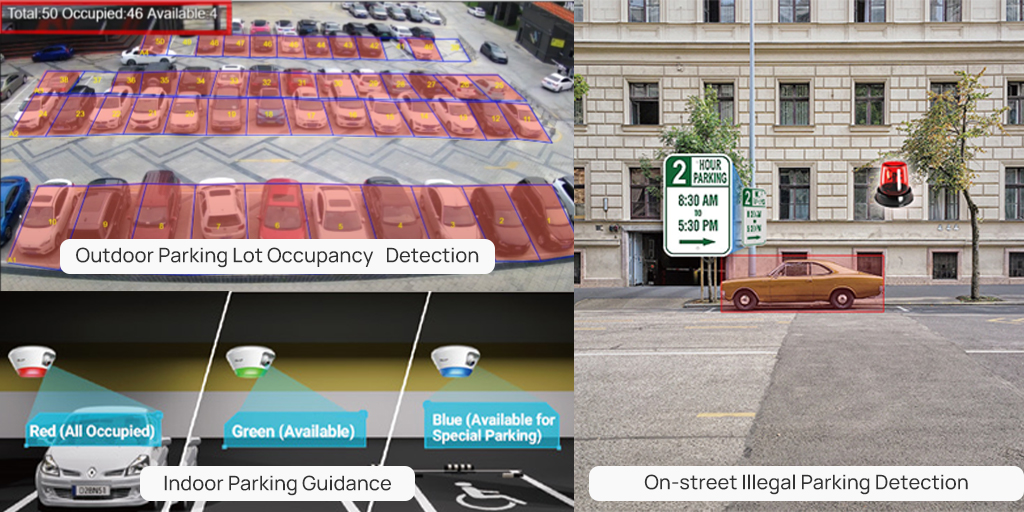
Best Practices for Optimal License Plate Recognition
To achieve optimal license plate recognition, it is essential to implement best practices that enhance system performance. Understanding the differences between various camera types, such as LPC and LPR, is the first step in selecting the right equipment for your specific needs. Following these installation guidelines will further ensure that the LPR system operates effectively, maximizing capture and recognition rates in diverse environments.
Pick the Right Cameras for Your Need: LPC vs LPR
With the advanced update and decreased cost, LPR technology is developing its application in extensive industries, such as law enforcement, commercial security, and parking lot management.
Two types of license plate cameras will be mentioned when discussing LPR technology. These are the LPC (license plate capture) camera and the LPR camera (also known as the license plate reader camera).
|
Features |
LPC Camera |
LPR Camera |
|
Core Function |
Captures and records images of license plates. |
Captures, records, reads, and analyzes license plate numbers. |
|
Recognition |
Cannot automatically read or recognize license plate numbers. |
Can automatically read license plate numbers using OCR. |
|
Database Matching |
Cannot automatically match plates against databases. |
Can match recognized plate numbers against databases for various functions (e.g., access control, law enforcement). |
|
Applications |
Homeowners, small/medium businesses for visual identification |
Access control (gates, facilities), highway tolling/monitoring, |
Considerations in the License Plate Recognition Camera Installation
Proper installation is critical for LPR system performance. Following these guidelines ensures optimal capture and recognition rates:
Position a Proper Angle: Ensure cameras are installed at an angle that minimizes distortion and maximizes visibility of license plates. You should place the LPR camera at a horizontal angle from the license plate within ±30° to avoid tilting and causing character deformation, and at a pitch angle from the license plate of 15 to 30 degrees to reduce reflection interference.
Position a Proper Height: Ideally, the camera should be placed at a height of 3 to 10 feet from the floor so that it can capture the license plate in proper size for better vehicle plate recognition. On the other hand, if the LPR camera is used on the highway, you should place it at a height of 10-33 feet from the floor to enable long-distance capture.
Position Proper Lighting: Account for lighting conditions to avoid overexposure or underexposure during image capture. For example, you’d ensure the camera is positioned to avoid direct sunlight or glare from headlights, which can obscure license plates.
Conclusion
In summary, as urban environments become more dynamic, license plate recognition (LPR) technology proves indispensable for effective traffic management, parking optimization, and security enhancement. It helps improve safety in restricted areas, assists law enforcement in locating vehicles of interest, eases congestion on busy roads, and enhances the parking experience.
Leveraging cutting-edge LPR technology, Milesight's LPR cameras excel in addressing accuracy challenges across various conditions through advanced AI algorithms and the capability to capture rich vehicle attribute information. By embracing intelligent LPR solutions like those offered by Milesight, organizations can unlock unparalleled efficiency, security, and smarter management of vehicle movement. How can Milesight transform your operations? You can contact us for a consultation and more details.
Milesight Related Products
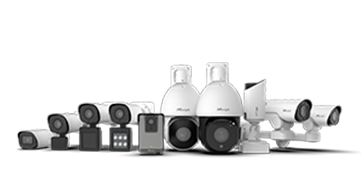
Road Traffic Management
With superior images, advanced AI LPR Algorithms, and customer-oriented solutions, Milesight fulfills your needs on road traffic management
Explore More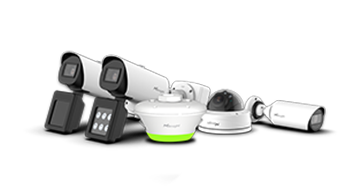
Parking Management
The Milesight AIoT Indoor Parking Management Suite integrates AI Deep Learning, On-edge LPR, LoRa, and dual-ultrasonic technologies. The ingenious combination optimizes the parking process and enhances management efficiency significantly.
Explore More


